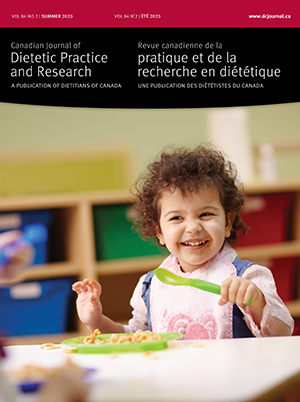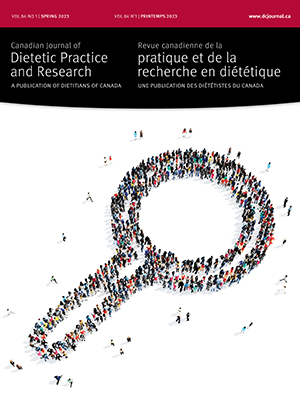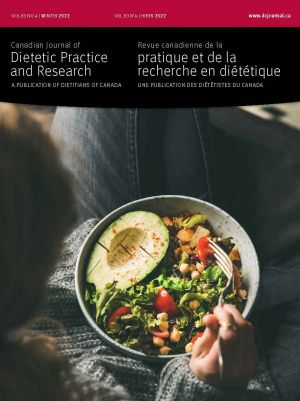Volume 78 • Number 4 • December 2017
Editor's Message
Research
Purpose: To examine the influence of peers and the source of meals and snacks on the dietary quality of adolescents seeking obesity treatment.Methods: Baseline surveys were completed by 173 adolescents with overweight or obesity (11–16 years old) enrolled in an e-health intervention in Vancouver, British Columbia. Dietary quality was assessed with three 24-h dietary recalls used to compute a Healthy Eating Index adapted to the Canadian context (HEI-C). Multiple linear regression examined associations between HEI-C scores and the frequency of: (i) meals prepared away from home, (ii) purchasing snacks from vending machines or stores, (iii) eating out with friends, and (iv) peers modeling healthy eating.Results: Adolescents reported eating approximately 3 lunch or dinner meals prepared away from home and half purchased snacks from vending machines or stores per week. After adjusting for socio-demographics, less frequent purchases of snacks from vending machines or stores (b = −3.00, P = 0.03) was associated with higher HEI-C scores. More frequent dinner meals prepared away from home and eating out with friends were only associated with lower HEI-C scores in unadjusted models.Conclusions: Snack purchasing was associated with lower dietary quality among obesity treatment-seeking adolescents. Improving the healthfulness of foods obtained away from home may contribute to healthier diets among these adolescents.
Perspecitves in Practice
Little has been published on cultural competency curriculum and dietetics considering the impact of food-related beliefs and behaviours on health. A 14-item online survey was administered in January 2016 to 145 participants (125 members of Dietitians of Canada Aboriginal Nutrition Network and 20 dietitians with an interest in Aboriginal nutrition). Questions included multiple choice and ranking responses and were pretested by 4 preceptors with the Northern Ontario Dietetic Internship Program (NODIP). Quantitative data analysis included frequencies, pivot tables, and averaging/grouping of ranking scores. A total of 42 individuals (29%) completed the survey. The majority rated the 5 health and cultural competencies and 6 food and nutrition competencies as “important” (90%–98% and 86%–100%, respectively). Overall, the competency related to identifying health status was ranked highest (78%), whereas developing culturally appropriate recipes was ranked lowest (83%). Most participants (95%) believed that all dietitians and graduating dietetic interns should be minimally competent in Aboriginal health and culture. The initial 11 draft competencies for dietetic interns were condensed to 6 minimum and 2 advanced competencies. Results will inform dietitians working with Aboriginal peoples and refinement of NODIP intern and preceptor tools, with the potential to integrate across Canadian dietetic internship programs.
Toronto Public Health conducted a pilot project to assess the feasibility of menu labelling by independent restaurants. The pilot project was informed by consultations with the industry and other jurisdictions that have implemented a similar initiative. Public Health Dietitians worked closely with these restaurants to help them work toward posting calories and sodium on their menus. This paper reports on the findings of a feasibility assessment that took a mixed-methods approach resulting in a comprehensive process evaluation. Results showed that having highly motivated restaurants and early adopters of menu labelling is a necessary starting point. However, this alone is not sufficient to make voluntary menu labelling successful. It may be feasible only for select independent restaurants who: (i) are highly motivated and ready to make a substantial time commitment; (ii) value offering healthy food choices; (iii) have fairly standardized recipes to begin with; (iv) receive extensive specialized, individualized support; and (v) receive incentives, cost offsetting, and recognition. Full-scale implementation of a menu labelling program with Toronto independent restaurants was not justified given the current level of interest and capacity.
Printed educational materials are a common source of health information, although their effectiveness in improving women’s knowledge or self-care in pregnancy has been questioned. This study describes the information in printed educational materials that address healthy eating during pregnancy and gestational weight gain (GWG) that are currently used in Alberta, Canada. Content of 6 resources was analyzed using a constant comparison qualitative approach. Resources emphasized healthy eating, prenatal supplements, folate supplementation, and healthy weight gain. More resources discussed the importance of “eating enough” than provided guidance on avoiding excessive GWG. Themes identified were: “everything is important” meaning that all healthy behaviours are important, making prioritization difficult; “more is more” emphasized eating more over moderation; “everyone is individual” suggests women seek individualized care through the care provider; and “contradictions” describes differences in content and recommendations within and between resources. New or revised versions of resources should provide congruent information with up-to-date recommendations that are easily prioritized. Care providers should be aware of contradictory information or information that does not align with current recommendations within printed educational materials and be ready to help women address the areas important for her personal behaviour change.
The present study investigated the feasibility, tolerability, and adherence of daily consumption of whole pulses (dried beans, peas, lentils, chickpeas) by individuals with peripheral artery disease participating in an 8-week study. Study questionnaires and semi-structured interviews for 26 participants were used to determine prestudy pulse consumption and participants’ experiences with respect to adherence, positive and negative effects, bowel routine, satiety, and enjoyment of the foods. Although the majority of participants rarely consumed pulses prior to the study, there was a high rate of adherence to daily consumption of the study foods for 8 weeks despite comments regarding study fatigue during the latter part of the study. Participants had no gastrointestinal side effects (42%) or experienced flatulence that resolved by week 4 (23%), whereas 62% reported improvements in their bowel pattern. By week 8 greater satiety was noted by some participants (19%), with the categories “less afternoon snacking” and “not snacking” receiving more responses. The key finding of this study was that consumption of pulses is a viable approach for this population; however, the frequency of consumption that is tolerable in the long term should be integrated with the dose and timeframe required to achieve and maintain health benefits.
We investigated the price difference between gluten-free (GF) and gluten-containing (GC) foods available in rural Maritime stores. GF foods and comparable GC items were sampled through random visits to 21 grocery stores in nonurban areas of Nova Scotia, New Brunswick, and Prince Edward Island, Canada. Wilcoxon rank tests were conducted on price per 100 g of product, and on the price relative to iron content; 2226 GF foods (27.2% staple items, defined as breads, cereals, flours, and pastas) and 1625 GC foods were sampled, with an average ± SD of 66 ± 2.7 GF items per store in rural areas and 331 ± 12 in towns. The median price of GF items ($1.76/100 g) was more expensive than GC counterparts ($1.05/100 g) and iron density was approximately 50% less. GF staple foods were priced 5% higher in rural stores than in town stores. Although the variety of GF products available to consumers has improved, higher cost and lower nutrient density remain issues in nonurban Maritime regions. Dietitians working in nonurban areas should consider the relative high price, difficult access, and low iron density of key GF items, and work together with clients to find alternatives and enhance their food literacy.
Review
En présence d’un environnement favorisant la sédentarité et l’accessibilité aux aliments, certains individus sont plus susceptibles au gain de poids. Cette différence individuelle peut s’expliquer par des interactions gène-environnement. En effet, il a été démontré que certains individus présentent une prédisposition génétique à l’obésité. De plus, une composante génétique a également été associée aux comportements alimentaires, tels que la restriction cognitive, la désinhibition et la susceptibilité à la faim, ces derniers étant également liés à l’obésité. L’objectif de cet article de revue est de présenter l’état des connaissances en ce qui a trait à l’héritabilité de certains comportements alimentaires, puis d’identifier les gènes associés à ces comportements. Les résultats démontrent que la désinhibition et la susceptibilité à la faim sont deux comportements alimentaires particulièrement héritables et que plusieurs gènes candidats sont maintenant associés aux comportements alimentaires. Ces résultats indiquent que l’on est loin d’être tous égaux face aux aliments et peuvent aider les professionnels à mieux comprendre la variabilité observée en contexte d’intervention. L’identification des gènes associés aux comportements alimentaires s’avère primordiale afin de mieux identifier les individus plus à risque de gain de poids et de mieux intervenir auprès de ces derniers.
Report
Purpose: This research aimed to estimate the percent energy (%E) contribution from total and free sugars in the Eating Well with Canada’s Food Guide (CFG) dietary pattern.Methods: The sugar-containing foods in the Canadian Nutrient File were assigned to 1 of 2 categories: total sugars or free sugars based on the source. The total sugars content of foods containing any amount of free sugars was assigned to the free sugars category. We estimated free sugars content from 8000 simulated diets (500 for each of the 16 age and sex groups), consistent with the CFG dietary pattern. Descriptive statistics were used to examine distributions of %E from total and free sugars by age and sex.Results: The mean %E from total and free sugars of all simulated diets was 21%E and 7%E, respectively. For simulated diets for males and females, 9–18 years of age, the %E from free sugars exceeded 10% at the 75th percentile. Simulated diets for all other age and sex groups exceeded 10%E from free sugars at the 95th percentile.Conclusions: The majority of the simulated CFG diets met the WHO recommendations to limit free sugars consumption to <10%E. These results will be used to inform future dietary guidance policy development.
Purpose: We compared food insecurity status, coping strategies, demographic characteristics, and self-rated health of international and domestic postsecondary students requesting emergency food hampers from a campus food bank (CFB).Methods: We collected data from a cross-sectional convenience sample of domestic and international students who accessed the CFB at the University of Alberta.Results: Food insecurity was prevalent (international students: n = 26/27 (96.2%), domestic students: n = 31/31 (100%)). Compared with their domestic peers, international students were less likely to rate their mental health negatively (14.8% vs 38.7%, P = 0.04). The primary income source was government loans (54.8%) for domestic students and research assistantships (33.3%) for international students. To cope with not having enough money for food, the majority of both student groups delayed bill payments or buying university supplies, applied for loans or bursaries, purchased food on credit, or worked more. International students were less likely to ask friends or relatives for food (48.1% vs 77.4%, P = 0.02).Conclusions: Domestic and international students mostly used similar coping strategies to address food insecurity; however, they paid for their education using different income sources. Distinct strategies for international and domestic students are required to allow more students to cover their educational and living expenses.
Purpose: Little is known about the lifestyle (e.g., physical activity, nutrition) information needs among breast cancer survivors living in nonurban settings. This study determined lifestyle information sources, needs, and preferences among breast cancer survivors in Northern British Columbia (BC), Canada.Methods: A cross-sectional, paper-based survey was distributed to a random sample of breast cancer survivors (n = 300) in Northern BC, which was generated through the BC Cancer Registry.Results: A total of 132 breast cancer survivors responded (true response rate = 49%; 132/270 received surveys). Two-thirds lived in rural and remote locations. The most commonly reported need was diet and physical activity (58%) to decrease risk of recurrence or improve survival. The most frequently identified sources of lifestyle information included physicians, family or friends, the internet, and magazines. A majority of breast cancer survivors (64%) preferred face-to-face interactions when considering potential lifestyle-related programs or services; distance-based formats (e.g., videoconferencing) were least preferred (11%).Conclusions: There is strong interest in information about lifestyle behaviours among breast cancer survivors in nonurban settings such as Northern BC. Future research is needed to investigate how best to deliver evidence-based lifestyle-related information to breast cancer survivors residing in nonurban settings.










